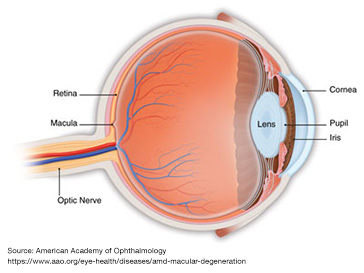Extraordinary Health
News and Information

A simple eye exam is key to saving your sight from this Age-Related Macular Degeneration, but do you know what it is?
Need an Eye Doctor?Schedule an appointment with a McFarland Eye Center ophthalmologist or optometrist. |
Age-Related Macular Degeneration (AMD) is the leading cause of blindness among seniors. It is a degenerative disease of the retinal pigment epithelium (RPE).
"RPE is a 'caretaker' of the retina," said Dr. Tracy Kangas, McFarland Clinic ophthalmologist. "RPE brings in nutrients and recycles metabolites, and when it fails, the retina fails also."
Over time retinal damage from AMD can lead to permanent loss of central vision, limiting your ability to drive, read and recognize faces.
 Wet AMD occurs when new, abnormal blood vessels grow under the retina and leak blood or fluid in the macula, results in scarring. The wet form of AMD is less common but can lead to more serious vision loss, with most cases of AMD-related blindness being caused by wet AMD. You lose vision more quickly with wet AMD than with dry AMD.
Wet AMD occurs when new, abnormal blood vessels grow under the retina and leak blood or fluid in the macula, results in scarring. The wet form of AMD is less common but can lead to more serious vision loss, with most cases of AMD-related blindness being caused by wet AMD. You lose vision more quickly with wet AMD than with dry AMD.
The dry form of AMD is very common. About 80 to 90 percent of people who have AMD have the dry form. It occurs when parts of the macula get thinner with age and tiny clumps of protein called drusen grow, causing you to slowly lose central vision.
"For a long time, there was no effective treatment for wet AMD," said Dr. Kangas. "Since 2005, however, we have had medicines that can be injected directly into the eyeball to slow the progression of wet AMD and improve or maintain vision." With the use of intravitreal Avastin, Lucentis and Eylea, about 30 percent of patients can get improved vision. Another two thirds of patients can see their vision stabilize, preventing further loss of vision. These treatments have decreased the incidence of blindness due to wet AMD, however it is imperative to be diagnosed and begin treatment as soon as possible to protect your vision.
Although there is no effective medication to treat dry AMD, certain nutritional supplements may be beneficial for people who have it. Age-Related Eye Disease Study 2 (AREDS 2) eye vitamins have been shown to decrease the risk of severe vision loss by 25 percent in patients with dry AMD. Speak to a McFarland Eye Center provider to learn more about vitamins recommended from AREDS #2.
There are several things you can do to help potentially avoid AMD and other eye diseases:
AMD often has no early warning signs, so getting regular comprehensive eye exams at your nearest McFarland Eye Center is critical to diagnosing and treating the eye disease in its early stages. The American Academy of Ophthalmology (AAO) recommends that people over age 65 get an exam every one to two years, even if you have no symptoms of eye problems.
Numerous studies have shown smoking to increase the risk of developing AMD and the speed at which it progresses. If you smoke you are two to three times more likely to develop macular degeneration compared with a nonsmoker.
If you have a close relative with AMD, you have twice the risk of developing the condition yourself. Sharing information about your family's eye history with your McFarland Eye Center provider may prompt him or her to recommend more frequent eye exams. The earlier AMD is caught, the better chance you may have of saving your vision.
"Vegetables like spinach and kale have high concentrations of lutein, a pigment that your RPE loses as AMD progresses," Dr. Kangas said, "so routinely eating a colorful plate of vegetables decreases your risk of AMD." Other studies have shown that people who have diets rich in omega-3 fatty acids, such as fish, have a decreased risk of AMD. An increased risk of AMD was found in people with diets high in saturated fats and cholesterol and in people with a higher body mass index (BMI).
Getting regular exercise can benefit your eyes. One study found that exercising three times a week reduced the risk of developing wet AMD over 15 years by 70 percent.
For more information, call or visit a provider at your nearest McFarland Eye Center. You can also read more information from the American Academy of Ophthalmology.